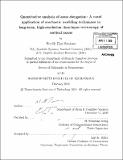| dc.contributor.advisor | H. Sebastian Seung. | en_US |
| dc.contributor.author | Sanjana, Neville Espi | en_US |
| dc.contributor.other | Massachusetts Institute of Technology. Dept. of Brain and Cognitive Sciences. | en_US |
| dc.date.accessioned | 2010-09-02T17:21:23Z | |
| dc.date.available | 2010-09-02T17:21:23Z | |
| dc.date.copyright | 2010 | en_US |
| dc.date.issued | 2010 | en_US |
| dc.identifier.uri | http://hdl.handle.net/1721.1/58281 | |
| dc.description | Thesis (Ph. D.)--Massachusetts Institute of Technology, Dept. of Brain and Cognitive Sciences, 2010. | en_US |
| dc.description | Cataloged from PDF version of thesis. | en_US |
| dc.description | Includes bibliographical references (p. 64-70). | en_US |
| dc.description.abstract | Axons exhibit a rich variety of behaviors, such as elongation, turning, branching, and fasciculation, all in service of the complex goal of wiring up the brain. In order to quantify these behaviors, I have developed a system for in vitro imaging of axon growth cones with time-lapse fluorescence microscopy. Image tiles are automatically captured and assembled into a mosaic image of a square millimeter region. GFP-expressing mouse cortical neurons can be imaged once every few minutes for up to weeks if phototoxicity is minimized. Looking at the data, the trajectories of axon growth cones seem to alternate between long, straight segments and sudden turns. I first rigorously test the idea that the straight segments are generated from a biased random walk by analyzing the correlation between growth cone steps in the time and frequency domain. To formalize and test the intuition that sharp turns join straight segments, I fit a hidden Markov model to time series of growth cone velocity vectors. | en_US |
| dc.description.abstract | (cont.) The hidden state variable represents the bias direction of a biased random walk, and specifies the mean and variance of a Gaussian distribution from which velocities are drawn. Rotational symmetry is used to constrain the transition probabilities of the hidden variable, as well as the Gaussian distributions for the hidden states. Maximum likelihood estimation of the model parameters shows that the most probable behavior is to remain in the same hidden state. The second most probable behavior is to turn by about 40 degrees. Smaller angle turns are highly improbable, consistent with the idea that the axon makes sudden turns. When the same hidden Markov model was applied to artificially generated meandering trajectories, the transition probabilities were significant only for small angle turns. This novel application of stochastic models to growth cone trajectories provides a quantitative framework for testing interventions (eg. pharmacological, activity-related, etc.) that can impact axonal growth cone movement and turning. For example, manipulations that inhibit actin polymerization increase the frequency and angle of turns made by the growth cone. More generally, axon behaviors may be useful in deducing computational principles for wiring up circuits. | en_US |
| dc.description.statementofresponsibility | by Neville Espi Sanjana. | en_US |
| dc.format.extent | 70 p. | en_US |
| dc.language.iso | eng | en_US |
| dc.publisher | Massachusetts Institute of Technology | en_US |
| dc.rights | M.I.T. theses are protected by
copyright. They may be viewed from this source for any purpose, but
reproduction or distribution in any format is prohibited without written
permission. See provided URL for inquiries about permission. | en_US |
| dc.rights.uri | http://dspace.mit.edu/handle/1721.1/7582 | en_US |
| dc.subject | Brain and Cognitive Sciences. | en_US |
| dc.title | Quantitative analysis of axon elongation : a novel application of stochastic modeling techniques to long-term, high-resolution time-lapse microscopy of cortical axons | en_US |
| dc.title.alternative | Novel application of stochastic modeling techniques to long-term, high-resolution time-lapse microscopy of cortical axons | en_US |
| dc.type | Thesis | en_US |
| dc.description.degree | Ph.D. | en_US |
| dc.contributor.department | Massachusetts Institute of Technology. Department of Brain and Cognitive Sciences | |
| dc.identifier.oclc | 639302908 | en_US |
